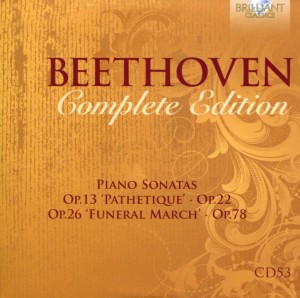 Today’s CD, like so many others, features some of Beethoven’s best work – at least, to my ears.
Today’s CD, like so many others, features some of Beethoven’s best work – at least, to my ears.
For example, the first composition – Piano Sonata No. 8 in C Minor Op. 13 “Pathetique,” which is analyzed on Wikipedia in this entry:
Ludwig van Beethoven’s Piano Sonata No. 8 in C minor, Op. 13, commonly known as Sonata Pathétique, was written in 1798 when the composer was 27 years old, and was published in 1799. Beethoven dedicated the work to his friend Prince Karl von Lichnowsky. Although commonly thought to be one of the few works to be named by the composer himself, it was actually named Grande sonate pathétique (to Beethoven’s liking) by the publisher, who was impressed by the sonata’s tragic sonorities.
Prominent musicologists debate whether or not the Pathétique may have been inspired by Mozart’s piano sonata K. 457, since both compositions are in C minor and have three very similar movements. The second movement, “Adagio cantabile”, especially, makes use of a theme remarkably similar to that of the spacious second movement of Mozart’s sonata. However, Beethoven’s sonata uses a unique motif line throughout, a major difference from Haydn or Mozart’s creation.
This sounds more like Beethoven than the pieces he dedicated to Haydn. It’s dynamic, with an emphasis on introspection and melancholy.
Coincidentally, as I was listening to this piece, I wondered if there was any particular key in which Beethoven often wrote. Or, more specifically, my question (to myself) was, “Did Beethoven have a particular key he favored?”
At the bottom of the Wiki entry was a link to a page called Beethoven and C Minor, which revealed this:
In the compositions of Ludwig van Beethoven, C minor is commonly regarded as a special key: works for which he chose this key are felt to be powerful and emotionally stormy.
During the Classical era, the key of C minor was used infrequently and always for works of a particularly turbulent cast.[citation needed] Mozart, for instance, wrote only very few works in this key, but they are among his most dramatic ones (the twenty-fourth piano concerto, the fourteenth piano sonata and the Great Mass in C minor, for instance). That Beethoven chose to write a much larger proportion of his works in this key, especially traditionally “salon” (i.e. light and diverting) genres such as sonatas and trios, was a sort of conscious rejection of older aesthetics, valuing the “sublime” and “difficult” above music that is “merely” pleasing to the ear.
The key is said to represent for Beethoven a “stormy, heroic tonality”; he uses it for “works of unusual intensity”; and it is “reserved for his most dramatic music.”
Pianist and scholar Charles Rosen writes:
“Beethoven in C minor has come to symbolize his artistic character. In every case, it reveals Beethoven as Hero. C minor does not show Beethoven at his most subtle, but it does give him to us in his most extrovert form, where he seems to be most impatient of any compromise”.
A characteristic 19th-century view is that of the musicologist George Grove, writing in 1898:
“The key of C minor occupies a peculiar position in Beethoven’s compositions. The pieces for which he has employed it are, with very few exceptions, remarkable for their beauty and importance.”
A-ha!
So Beethoven did have a key that he favored – when he wanted to be particularly dynamic, expressive, “stormy.”
This is the kind of information for which I began this journey!
Movement II (“Adagio cantabile”) is a famous melody. Here. Listen for yourself:
There’s a contemporary song that uses Beethoven’s melody. I’m trying to think of its name. But this music, combined with the din at Panera Bread, is blocking me. I’ll remember it sometime.
I did!
 Or, more truthfully, I Googled the movement with the term “rock music” added to my search.
Or, more truthfully, I Googled the movement with the term “rock music” added to my search.
Here’s what I came up with: “The rock band Kiss incorporated it into “Great Expectations” from their album Destroyer.” (From the web site Classic Cat.)
Piano Sonata No. 11 in B Flat Op. 22
According to its entry on Wiki:
Beethoven’s Piano Sonata No. 11 in B-flat major, Op. 22, was composed in 1800.
Prominent musicologist Donald Francis Tovey has called this work the crowning achievement and culmination of Beethoven’s early “grand” piano sonatas. Subsequent sonatas find Beethoven experimenting more with form and concept.
A very nice piece of music.
Piano Sonata No. 12 in A Flat Op. 26 “Funeral March”
According to its entry on Wiki:
Ludwig van Beethoven composed his Piano Sonata No. 12 in A-flat major, Op. 26, in 1800–1801, around the same time as he completed his First Symphony. He dedicated the sonata to Prince Karl von Lichnowsky, who had been his patron since 1792.
The structure of the sonata is unconventional in that the piece opens with a relatively slow movement in the format of theme and variations. In contrast, the remaining movements of the sonata proceed according to classical principles in fast-slow-fast alternation. The third movement incorporates a funeral march, clearly anticipating the watershed of the Eroica Symphony that Beethoven wrote in 1803-1804. This is the only movement from his sonatas that Beethoven arranged for orchestra, and was played during Beethoven’s own funeral procession in 1827.
This sonata is also unusual in that none of its four movements is in sonata-allegro form.
Piano Sonata No. 24 in F Sharp Op. 78
According to its entry on Wiki:
The Piano Sonata No. 24 in F-sharp major, Op. 78, nicknamed “à Thérèse” (because it was written for Countess Thérèse von Brunswick) was written by Ludwig van Beethoven in 1809. It consists of two movements.
Once again, the legendary Alfred Brendel performs Beethoven’s piano sonatas.
